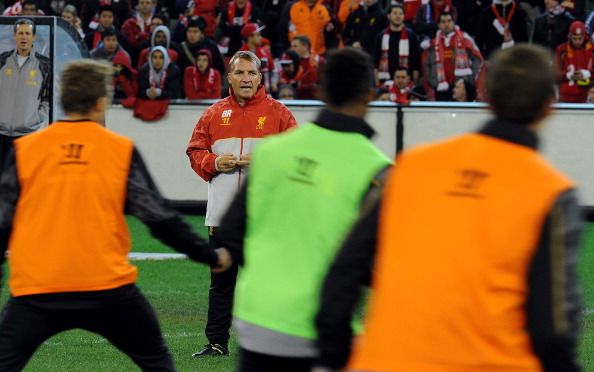
Analysing the 3-5-2 formation at Liverpool
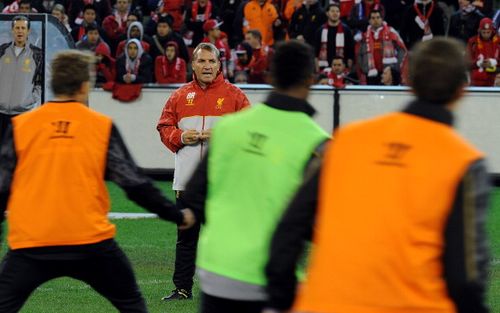
Brendan Rodgers – Man on a mission
The return of Luis Suarez to the team after his ban, combined with injuries to some key players forced Brendan Rodgers to revamp the Liverpool team formation to a dynamic 3-5-2 system, and the players have responded brilliantly to the change by putting in some impressive performances. The 3-5-2 formation has been used successfully by Cesare Prandelli with the Italian national team and Antonio Conte at Juventus and is also quite common in the South American leagues, but hasn’t been seen much in the English Premier League.
Liverpool do not boast of many naturally wide attacking players, but with the depth in central defence, and versatility offered by players like Jordan Henderson and Mamadou Sakho, the new system seems to be working well for the team which gets to play to its strengths, and makes up for its deficiencies.
Rodgers feels that the system fits in well with his philosophy of pass and move fluidity and that it allows the team to have more players in the attacking third:
“It gives us numbers going forward, which is important. It’s another system that the players have shown we can play. With more play and more development, it’s one that we can flip to quite easily.
It’s wherever you can get superiority in the game. If I look at Daniel and Luis Suarez, they are both nine-and-a-halves. They are not straight up and down strikers, they like to move and get in between.
The game is evolving all the time; as a coach you are always looking at your players. The style never changes.
I’ve always asked teams to control and dominate the ball, be aggressive in your defending, and press really aggressively and high up the pitch – but that can be in whatever system.
The system is irrelevant; it’s normally based on the characteristics of your players. If you have got them [Sturridge and Suarez] through the middle, moving and interchanging, then your structure has to then change behind that, and that’s obviously something that we have done.”
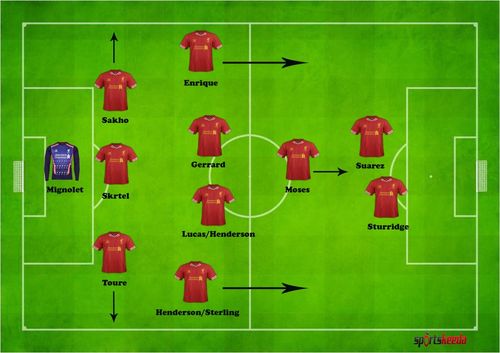
Liverpool team playing in the 3-5-2 formation in the recent matches
The 3-5-2 system was first introduced by Rodgers in the 1-0 League Cup defeat to Manchester United, but the tactics worked well for the team in the Premier League as the team beat Sunderland and Crystal Palace comfortably. It remains to be seen if Rodgers continues to use the formation for a longer period, but there are some key aspects to this system that mesh very well with the Liverpool team’s resources and abilities. But given the success and promise of the system, Rodgers will be tempted to continue this further, more so when the likes Glen Johnson, Philippe Coutinho return back from injuries.
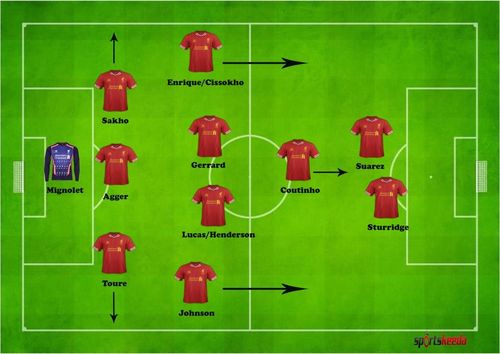
Likely Liverpool team in the 3-5-2 formation after the return of players from injury
Here are some of the factors which go in favour of Rodgers deciding to continue with the 3-5-2 formation:
A flexible system that can adapt its shape depending on game situation
The formation becomes a fluid and attacking 3-4-3 when Liverpool have the possession, and while defending, the wing-backs and the ‘number 10’ player drop back to make it a 5-3-2. This maximizes the numbers for the team in both attack and defence. It also gives the team options from both flanks as well down the middle, thus making the attacks less predictable compared to last year and giving more chances to Suarez and Sturridge to score goals.
‘SAS’ get to play upfront and Coutinho in number 10 role
The system ensures that both Suarez and Sturridge (SAS) get to play in their preferred positions, and also creates a spot for Philippe Coutinho when he returns to the team after his injury.
In the 4-3-3 formation that Rodgers has typically deployed, one of either Sturridge or Suarez would have had to move to the flanks. But with the 3-5-2 system, both get to play in the striker positions. Both have freedom to roam on the flanks, and also drop deep to link up in the midfield, but whenever the team is in possession, they have based in the centre of the attack which maximizes their goal scoring chances. Playing close together, the SAS duo will also develop a better understanding of each other’s games and should be able to set up chances for the other to score from.
The system also creates a perfect number 10 position for Philippe Coutinho when he re-joins the team. Operating in the hole behind the SAS duo (where Victor Moses has currently been plying), Coutinho is likely to become a nemesis for the opposition defences by creating goal scoring opportunities for Suarez and Sturridge to capitalize upon.
Leveraging the attacking skills of the full-backs
Both Glen Johnson and Jose Enrique are very good at going forward, but have been often slammed for lacking defensive acumen. But in the new system, they won’t be starting as a wing-back, nor would be they play as a winger either. The presence of the 3 centre-backs will cover up for their defensive frailties and they will relish having the freedom to move ahead and attack, and also dropping back to help the defence when required. Aly Cissokho, who is also offensively minded, will offer Rodger an alternative to Enrique’s position at LWB once he returns from injury.
Johnson has been out injured for a while now, but should fit in the system seamlessly on his return. In his absence, Henderson and Raheem Sterling have shown their versatility by slotting into the RWB position with good work-rate.
Increases playing opportunities to the centre-backs in the team
With the purchases of Kolo Toure, Mamadou Sakho, Tiago Ilori in the summer transfer window, and the resurgence of Martin Skrtel after a small blip in form, Rodgers would have faced a tough task of selecting only 2 centre-backs out of a squad loaded with some top-class talent. Add team vice-captain Daniel Agger, who is recovering from an injury at present, to the mix, and the dilemma only gets compounded further. The 3-5-2 systems lets Rodgers selects an extra centre-back in the starting XI, and with a good blend of left-footed (Agger, Sakho) and right-footed (Toure, Skrtel) players, Rodgers can play one of the them on either flank of the defence, and one to marshal at the centre.
The alternative: reverting back to the 4-3-3 formation
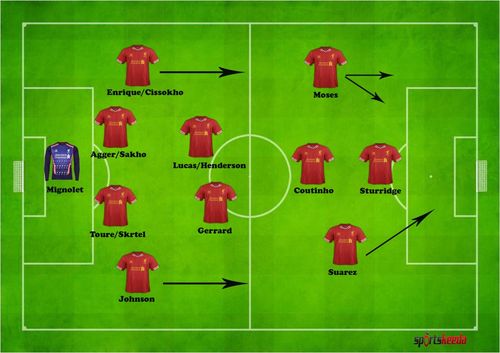
Rodgers can revert back to his traditionally preferred 4-3-3 formation
In case Rodgers decides to revert back to the 4-3-3 system that he is known to traditionally prefer, it is likely to see Suarez and Sturridge switching between the centre and flanks on the attack, and Victor Moses attacking from the left wing. This system will have the usual 4 member defence with wing-backs looking to advance whenever possible, and Steven Gerrard and Lucas Leiva providing cover to the defence from the midfield.
Verdict:
Brendan Rodgers has finally managed to assemble a squad that can play to his strategy and tactics. With competition in most positions, and the players being able to ply in different roles with versatility, Rodgers has got the luxury to get the team to play the kind of game he wants them to. The move to use the 3-5-2 formation was forced due to injuries to key players. But after seeing the effectiveness with which the 3-5-2 formation has worked, and also how it suits the squad’s playing skills, he will certainly be tempted to continue using this in future as well. Of course, if things don’t work out with this system, he can always fall back on his preferred 4-3-3 formation, with which he has achieved success in the past.
If the Liverpool team can continue their good form under the new tactics by Rodgers, then the fans can certainly look forward to the team having a strong season ahead and be genuine contenders for a spot in next season’s Champions League.